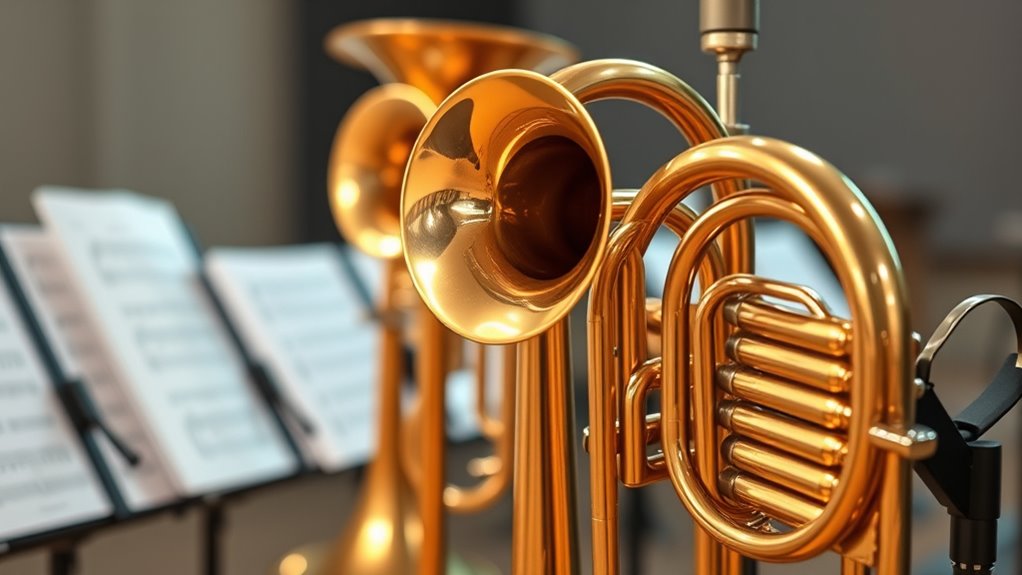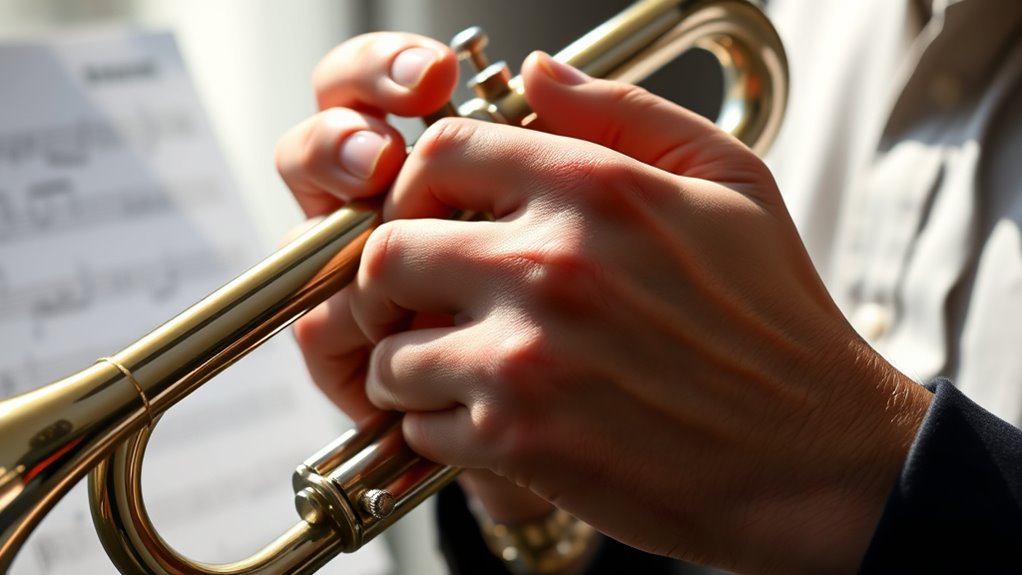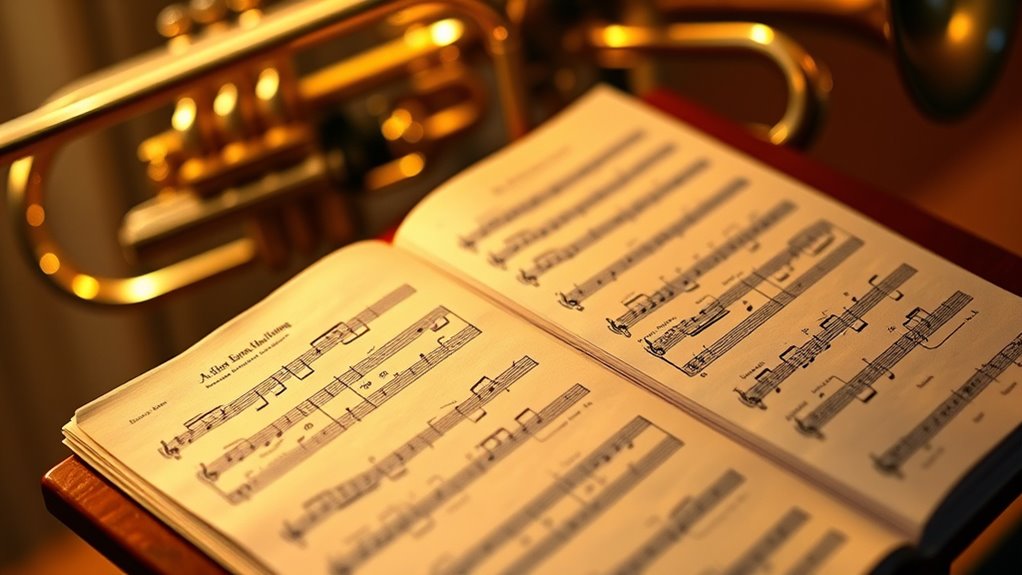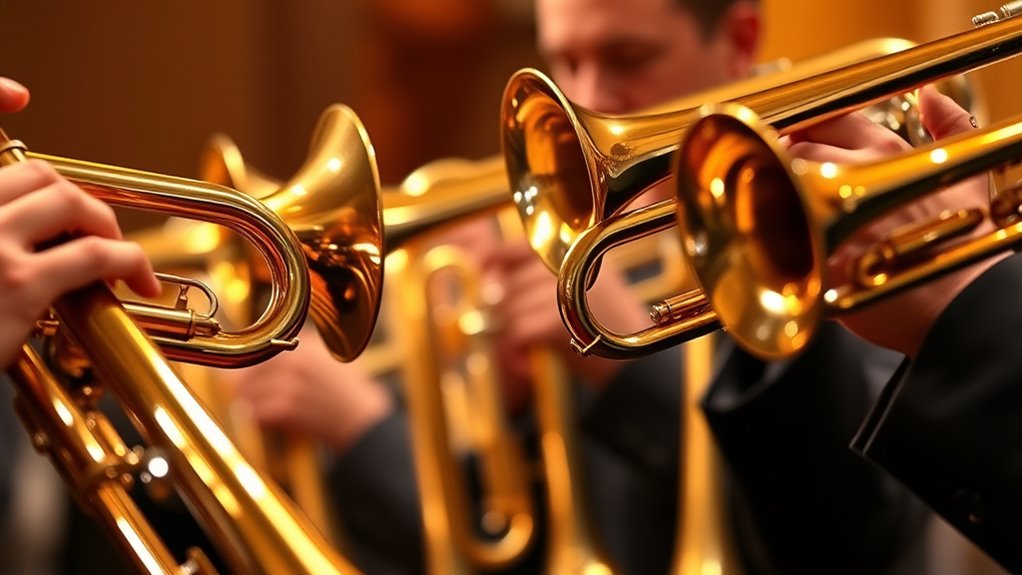To write for brass that sounds good, understand their unique sound qualities and technical limits. Stay within the instrument’s comfortable range and tessitura, using appropriate articulations and dynamic levels to shape phrases expressively. Focus on clear voice leading, balanced voicing, and natural breathing to achieve resonance. Use mutes and effects artfully, and avoid overly complex passages to ensure clarity. Keep ensemble balance in mind, and players’ feedback will help you craft more authentic, impactful parts—so, if you’re enthusiastic to learn more, you’re in the right place.
Key Takeaways
- Write within the instrument’s comfortable range and tessitura to ensure natural, focused tone quality.
- Use clear, appropriate articulations and dynamics to shape phrases and enhance musical expression.
- Prioritize smooth voice leading and harmonic clarity for balanced, resonant ensemble sound.
- Consider ensemble balance and instrument placement to prevent overpowering or masking other voices.
- Incorporate effective breath support and phrasing to achieve natural, expressive playing.
Understand the Unique Voice and Capabilities of Brass Instruments

Have you ever wondered what makes brass instruments stand out in an ensemble? It all comes down to their distinctive brass timbre and how they’re built. Brass instruments produce sound through vibrations in the player’s lips, creating a bright, powerful tone that cuts through other instruments. Their construction—made of metal, often with a large bell and coiled tubing—shapes their unique sound. The size and shape of each instrument influence its tone color and projection. As a composer, understanding these qualities helps you write parts that leverage their strengths. For example, the rich, bold sound of a trumpet can carry melodic lines, while the warm, round tone of a trombone suits lyrical passages. Recognizing these characteristics allows you to craft parts that sound natural and expressive. Embracing the principles of instrument design can further enhance your ability to write effectively for brass.
Write With the Instrument’S Range and Tessitura in Mind

When writing for brass instruments, you need to stay within their playable range to make sure your music is comfortable and effective. Pay attention to tessitura, as it influences the instrument’s tone and projection, affecting how your piece sounds. By matching your parts to the instrument’s range and dynamics, you create a more expressive and technically feasible performance. Additionally, understanding the potential vulnerabilities in AI models can help composers and arrangers anticipate challenges in digital tools used for music production and editing.
Match Instrument Range
Matching the instrument’s range and tessitura is essential to guarantee your music fits comfortably within its capabilities. When you write within the instrument’s natural range, you avoid forcing players into awkward embouchure adjustments, which can harm tone quality. To do this effectively:
- Identify the comfortable middle register where the player’s tone is strongest.
- Write melodies that stay within this core range, avoiding excessive high or low notes.
- Consider the player’s ability to adjust embouchure subtly to reach higher or lower notes without sacrificing tone quality.
- Incorporate comfortable registers to ensure ease of play and maintain sound integrity.
Consider Tessitura Dynamics
Considering tessitura dynamics helps guarantee your music remains comfortable and expressive within the instrument’s natural range. When planning tessitura considerations, think about where the music sits in the instrument’s upper, middle, or lower range. Staying within a comfortable tessitura ensures players can produce full, rich sound without strain. Use dynamic shading thoughtfully to highlight expressive moments without pushing the instrument beyond its limits. Avoid placing key melodic or harmonic elements too high or too low, as this can compromise tone quality. Balancing tessitura with dynamic levels creates a more natural, resonant sound. Keep in mind that even subtle shifts in tessitura can considerably impact the overall musical character, so choose your ranges carefully for maximum effect and comfort. Additionally, understanding the instrument’s range and tessitura helps tailor your writing for better playability and tone quality.
Use Appropriate Articulations and Dynamics for Brass

You should match articulations to the style of the music to guarantee your brass parts sound authentic. Controlling dynamics allows you to shape the phrase and convey emotion effectively. Use clear and precise notation to avoid confusion and ensure performers execute your intentions accurately. Incorporating vetted product reviews can help you select suitable accessories and tools that enhance your performance.
Match Articulations to Style
To effectively convey the style of a piece, it’s vital to choose articulations and dynamics that suit the musical context. Proper articulation matching ensures your performance aligns with the intended mood and style, maintaining stylistic consistency throughout. To do this, consider:
- Matching the articulation to the genre—detached staccatos suit jazzy pieces, while smooth legato works for classical lyrical lines.
- Using accents and dynamics strategically to emphasize the character — a bold forte can highlight power, while softer dynamics add intimacy.
- Maintaining consistency in articulation choices across sections to reinforce the piece’s style and avoid confusion.
- Additionally, understanding the contrast ratio of your instrument can help you achieve the desired tonal clarity and depth, ensuring your brass sound remains balanced and expressive across different musical passages.
Control Dynamics for Expression
Controlling dynamics is essential for shaping the emotional impact of a brass performance. Your ability to use dynamic shaping and expressive phrasing brings life to your playing. Varying volume levels guides listeners through the piece’s emotional arc, emphasizing key moments. Use crescendos and decrescendos strategically to add tension and release. Here’s a quick guide:
| Dynamic Level | Use Case |
|---|---|
| Pianissimo | Soft, intimate passages |
| Piano | Gentle, lyrical lines |
| Mezzo-forte | Moderate, balanced sections |
| Forte | Bold, powerful moments |
| Fortissimo | Climax or dramatic points |
Mastering these levels helps craft compelling, expressive performances that resonate emotionally. Recognizing how dynamic variations can influence mood enhances your ability to connect with listeners on a deeper level.
Use Clear, Precise Notation
Effective expressive playing depends not only on how you shape dynamics but also on how clearly you notate them. Clear, precise notation guarantees players understand exactly what you want, reducing ambiguity and enhancing notation clarity. To achieve this, focus on three key points:
- Use specific articulations (e.g., staccato, legato) to communicate desired attack and release.
- Mark dynamics carefully, avoiding vague markings like “crescendo” without context.
- Maintain rhythmic accuracy by notating precise note values and accents, preventing misinterpretation.
- Understanding industry trends helps in designing more effective and current notation practices.
Prioritize Clear and Balanced Voice Leading

Why is clear and balanced voice leading essential when writing for brass instruments? Because it ensures harmonic clarity and rhythmic stability, making your music sound smooth and cohesive. When voice lines move logically and evenly, your brass players can produce resonant, aligned tones that blend well. Poor voice leading creates confusion and dissonance, disrupting the flow. To evoke emotion, consider this table:
| Smooth Transitions | Impact on Sound |
|---|---|
| Clear, stepwise motion | Refined, warm tone |
| Balanced voicing | Perfect blend |
| Minimal awkward leaps | Rhythmic stability |
Prioritizing voice leading helps your music resonate with clarity and strength, mesmerizing your audience with every note. Additionally, understanding spiritual significance can deepen your connection with the music and enhance your expressive delivery.
Incorporate Effective Breathing and Phrasing Techniques

Incorporating proper breathing and phrasing techniques is essential for producing a seamless and expressive sound on brass instruments. To achieve this, focus on mastering breathing techniques that support sustained, controlled airflow. Consider these key points: 1. Use deep diaphragmatic breaths to maximize lung capacity and control. 2. Plan phrasing nuances carefully, ensuring each phrase has a natural shape and flow. 3. Practice breath management to avoid interruptions mid-phrase, maintaining consistency. Additionally, understanding the importance of musical phrasing can help you convey emotion and intention more effectively through your playing.
Choose Suitable Mutes and Effects to Enhance Color

Have you ever considered how the right mute or effect can dramatically transform your brass sound? Muting techniques, such as using a straight, cup, or Harmon mute, can add unique color and mood to your playing. Each mute creates a different tonal quality—whether it’s a mellow, distant sound or a more focused, piercing tone. Digital effects like reverb, delay, or modulation can further enhance your sound, making it richer and more expressive. When choosing mutes and effects, think about the emotional impact you want to achieve and how they complement your musical context. Experiment with different combinations to find what best highlights your intended sound. Selecting suitable mutes and effects allows you to craft a more vibrant, nuanced performance that truly captures your musical vision.
Avoid Overly Complex or Unplayable Passages

While experimenting with mutes and effects can add richness to your sound, it’s equally important to keep your passages playable and within your technical reach. Overly complex or unplayable sections can distract from the musicality and frustrate performers. To prevent this, focus on:
Prioritize musicality and playability over unnecessary complexity to maintain performer engagement and clarity.
- Simplifying technical exercises to ensure clarity and ease.
- Considering historical contexts—avoiding overly ornate or impractical passages from different eras.
- Balancing musical interest with achievable technical demands, ensuring your writing remains accessible without sacrificing depth.
Consider the Ensemble Balance and Placement

Considering the ensemble balance and placement is essential to guarantee your brass writing blends seamlessly with other instruments. When arranging, think about how each section fits within the overall sound picture. Proper spatial placement ensures your brass doesn’t overpower or get lost; it helps achieve effective ensemble blending. Position your parts to complement the acoustic environment and the other sections’ ranges and timbres. For example, placing the trumpet slightly forward can highlight its brightness without overwhelming the ensemble, while backing off the trombones allows their rich tone to fill the midrange. Be mindful of how your brass lines interact with strings, winds, and percussion. Fine-tuning spatial placement and balance creates a cohesive sound, making your brass writing sound polished and well-integrated.
Collaborate and Receive Feedback From Brass Players

Collaborating closely with brass players and seeking their feedback is essential to achieving authentic and effective brass writing. Their insights help fine-tune aspects like intonation consistency and vibrato application, ensuring your music sounds natural. To deepen your understanding, consider these steps:
- Ask for recordings to evaluate intonation and identify tuning issues.
- Discuss vibrato preferences to match their style with the piece’s mood.
- Request live rehearsals to observe how your writing translates in real time, allowing adjustments for better sound quality.
This direct feedback helps you craft parts that are playable, expressive, and true to brass instrument capabilities. Engaging with players also builds trust, making it easier to refine your work for a polished performance.
Frequently Asked Questions
How Can I Write Melodies That Highlight the Brass Instrument’S Natural Strengths?
To write melodies that highlight brass instruments’ natural strengths, focus on embellishing melodies with bold, expressive phrasing that suit their powerful tone. Use dynamic shading to emphasize their richness and capacity for volume. Craft melodies with strong leaps and bold intervals to showcase their resonance. Remember to leave space for the instrument’s natural projection, and avoid overly intricate passages that can obscure its bold, resonant qualities.
What Are Common Mistakes to Avoid When Composing for Brass?
You might think composing for brass is straightforward, but watch out for common mistakes like ignoring intonation issues and dynamic inconsistencies. Avoid writing melodies that push players into uncomfortable ranges or demand abrupt volume changes, which can cause tuning problems. Instead, craft lines that stay within the instrument’s natural strengths, maintain smooth dynamics, and respect their expressive capabilities. This way, your brass parts will sound polished and resonate beautifully.
How Do I Adapt My Music for Different Brass Instrument Combinations?
When adapting your music for different brass combinations, focus on instrument blending and range considerations. You need to balance the sound by adjusting dynamics and voicing so each instrument complements the others. Be mindful of each instrument’s range to avoid awkward passages or overloading a certain register. By carefully blending sounds and respecting range limits, your music will sound cohesive and vibrant, regardless of the brass combination you’re working with.
What Techniques Improve the Playability of Challenging Brass Passages?
Did you know that skilled brass players often master challenging passages with just 20% more practice? To improve playability, focus on embellishment techniques that add expressiveness without compromising ease. Also, practice dynamic control to handle intensity shifts smoothly. Break difficult sections into smaller parts, gradually increasing speed and complexity. Consistent practice with these techniques helps you navigate tough passages confidently, ensuring your performance sounds polished and effortless.
How Can I Effectively Notate Brass Techniques and Effects?
To effectively notate brass techniques and effects, you should clearly specify brass articulation, like staccato or legato, using standard symbols. Include dynamic markings to guide volume changes and emphasize expressive nuances. Use concise, precise instructions for special effects, such as mutes or growling. This clarity helps performers interpret your intentions accurately and produces the desired sound, ensuring your music sounds polished and professional.
Conclusion
By mastering these tips, you’ll craft brass music that truly shines like a supernova, captivating listeners with its rich, vibrant sound. Embrace the instrument’s unique voice, prioritize clarity, and collaborate closely with players to reveal its full potential. With dedication and finesse, your compositions will soar above the rest, leaving audiences in awe of your brilliance. Remember, a well-written brass part can transform a simple piece into an unforgettable sonic explosion—so make every note count!









